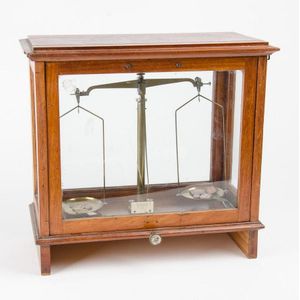Gothic Oak Library Bookcase, French 1865
You must be a subscriber, and be logged in to view price and dealer details.
Subscribe Now to view actual auction price for this item
When you subscribe, you have the option of setting the currency in which to display prices to $Au, $US, $NZ or Stg.
- Circa - A Latin term meaning 'about', often used in the antique trade to give an approximate date for the piece, usually considered to be five years on either side of the circa year. Thus, circa 1900 means the piece was made about 1900, probably between 1895 and 1905. The expression is sometimes abbreviated to c.1900.
- Gothic Style, Furniture - Gothic style furniture refers to pieces that are designed and crafted in the Gothic architectural and decorative style that was popular in Europe from the 12th to the 16th centuries. This style of furniture is characterised by its elaborate and ornate details, as well as its use of dark and heavy woods, such as oak and walnut.
Gothic style furniture often features intricate carvings and embellishments, including pointed arches, quatrefoils, and tracery. The style also frequently incorporates elements such as coats of arms, shields, and religious symbols. Gothic furniture often has a heavy and substantial appearance, and the pieces are often finished with a dark stain to accentuate the detailed carving and embellishments.
The furniture items can be quite large and imposing, and they are often used as statement pieces in large rooms. Gothic furniture can be a striking and dramatic addition to any space, and it is often appreciated by those who have an interest in medieval and historical design. - Oak - Native to Europe and England, oak has been used for joinery, furniture and building since the beginning of the medieval civilisation. It is a pale yellow in colour when freshly cut and darkens with age to a mid brown colour.
Oak as a furniture timber was superceded by walnut in the 17th century, and in the 18th century by mahogany,
Semi-fossilised bog oak is black in colour, and is found in peat bogs where the trees have fallen and been preserved from decay by the bog. It is used for jewellery and small carved trinkets.
Pollard oak is taken from an oak that has been regularly pollarded, that is the upper branches have been removed at the top of the trunk, result that new branches would appear, and over time the top would become ball-like. . When harvested and sawn, the timber displays a continuous surface of knotty circles. The timber was scarce and expensive and was used in more expensive pieces of furniture in the Regency and Victorian periods.
This item has been included into following indexes:
- bookcases, function or type
- bookcases, material - oak 213
- bookcases, period - Gothic style 45
Visually similar items

A large nickel bound display cabinet two glass shelves, single light, on four lion feet, 182 cm in length, 197 high

Teak room divider. Length 106.5 cm. Depth 30.5 cm. Height 176 cm

A George III oak standing corner cabinet, circa 1810, with astragal glazed doors enclosing shaped shelves, above inset panel doors, 101.5 width x 56 depth x 205 cm height

Balance scales & weights in mahogany & glass case, English, late 19th century. 33 cm high, 34 cm wide, 16 cm deep
